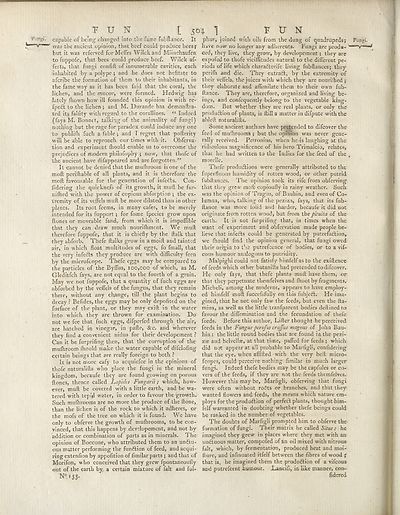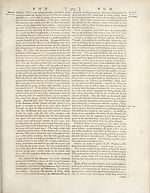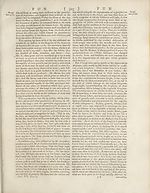Encyclopaedia Britannica > Volume 7, ETM-GOA
(544) Page 504
Download files
Complete book:
Individual page:
Thumbnail gallery: Grid view | List view

TUN L W 1 TUN
capable of being changed into the fame fubilance. It
was the ancient opinion, that beef could ptoduce bees?
but it was referved forMeffrs Wilckand Miinchaufen
to fuppofe, that bees could produce beef. Wilck af-
feits, that fungi confifl; of innumerable cavities, each
inhabited by a polype; and he does not hefitate to
afcribe the formation of them to their inhabitants, in
the fame way as it has been faid that the coral, the
lichen, and the mucor, were formed. Hedwig has
lately Ihown how ill founded this opinion is with re-
fpedl to the lichen ; and M. Durande has demonftra-
ted its falfity with regard to the corallines; “ Indeed
(fays M. Bonnet, talking of the animality of fungi)
nothing but the rage for paradox could induce any one
to publiih fuch a fable ; and I regret that pollerity
will be able to reproach cur times with it. Obferva-
tion and experiment fliould enable us to overcome the
fpvejudices of modern philofophy ; now, that thofe of
the ancient have difappeared and are forgotten.”
It cannot be denied that the mufhroom is one of the
moft perifhable of all plants, and it is therefore the
moft favourable for the generation of infedts. Con-
fidering the quicknefs of its growth, it mull be fur-
nifhed with the power of copious abforption ; the ex¬
tremity of its veffels muft be more dilated than in other
plants. Its root feems, in many cafes, to be merely
intended for its fupport; for fome fpecies grow upon
flones or moveable fand, from which it is impoffible
that they can draw much nourifbment. We muft
therefore fuppofe, that it is chiefly by the ftalk that
they abforb. Thefe ftalks grow in a moift and tainted
air, in which float multitudes of eggs, fo fmall, that
the very infefts they produce are with difficulty feen
By the microfcope. Thefe eggs may be compared to
the particles of the Byffus, 100,000 of which, as M.
Gleditfch fays, are not equal to the fourth of a grain.
May we not fuppofe, that a quantity of fuch eggs are
abforbed by the veffels of the fungus, that they remain
there, without any change, till the plant begins to
decay ? Befides, the eggs may be only depofited on the
furface of the plant, or they may exift in the water
into which they are thrown for examination. Do
not we fee that fuch eggs, difperfed through the air,
are hatched in vinegar, in pafte, &c. and wherever
they find a convenient nidus for their developement ?
Can it be furprifing then, that the corruption of the
mufhroom fhould make the water capable of difclofmg
certain beings that are really foreign to both ?
It is not more eafy to acquiefce in the opinions of
thofe naturalifts who place the fungi in the mineral
kingdom, becaufe they are found growing on porous
Hones, thence called Lapides Fungarii; which, how¬
ever, muft be covered with a little earth, and be wa¬
tered with tepid water, in order to favour the growth.
Such mufhrooms are no more the produce of the ftone,
than the lichen is of the rock to which it adheres, or
the mofs of the tree on which it is found. We have
only to obferve the growth of mulhrooms, to be con¬
vinced, that this happens by devffopement, and not by
addition or combination of parts as in minerals. The
opinion of Boccone, who attributed them to an unftu-
ous matter performing the fundftion of feed, and acqui¬
ring extenfion by appofition of fimilar parts ; and that of
Morifon, who conceived that they grew’ fpontaneoufly
©ut of the earth by^ a certain mixture of fait and ful-
Nsi33-
phur, joined with oils from the dung of quadrupeds; Fungi,
have now no longer any adherents. Fungi are proda- 't—
ced, they live, they grow, by developement; they are
expofed to thofe viciffitudes natural to the different pe¬
riods of life which chara&erife living fubftances; they
perifh -and die. They extradl, by the extremity of
their veffels, the juices with which they are nourifhed;
they elaborate and aifimilate them to their own fub-
ftance. They are, therefore, organized and living be¬
ings, and confequently belong to the vegetable king¬
dom. But whether they are real plants, or only the
produ&ion of plants, is ftill a matter in difpute with the
ableft naturalifts.
Some ancient authors have pretended to difcover the
feed of mu (brooms ; but the opinion was never gene¬
rally received. Petronius, when he is laughing at the
ridiculous magnificence of his hero Trimalcio, relates,
that he had written to the Indies for the feed of the .
morelle.
Thefe produ&ions w’ere generally attributed to the
fuperfluous humidity of rotten wood, or other putrid
fubftances. The opinion took its rife from obferving
that they grew’ moft copioufly in rainy weather. Such
was the opinion of Tragus, ofBaubin, and even of Co-
lumna, who, talking of the peziza, fays, that its fub-
ftance was more iolid and harder, becaufe it did not
originate from rotten wood, but from the pituita of the
earth. It is not furprifing that, in times when the
want of experiment and obfervation made people be¬
lieve that inlefts could be generated by putrefaftion,
we Ihould find the opinion general, that fungi owed
their origin to the putrefcence of bodies, or to a vif-
cous humour analogous to putridity.
Malpighi could not fatisfy himfelfasto the exiftence
of feeds which other botanifts had pretended to difcover.
He only fays, that thefe plants muft have them, or
that they perpetuate themfelves and (hoot by fragments.
Micheli, among the moderns, appears to have employ¬
ed himfelf moft fuccefsfully on this fubjeft. He ima¬
gined, that he not only faw the feeds, but even the fta-
mina, as well as the little tranfparent bodies deftined to
favour the diffemination and the fecundation of thefe
feeds. Before this author, Lifter thought he perceived
feeds in the Fungus per of us crajfus magnus of John Bau-
hin : the little round bodies that are found in the pezi¬
za; and helvellae, at that time, paffed for feeds ; which
did not appear at all probable to Mariigli, confidering
that the eye, vyhen affifted with the very bell micro-
fcopes, could perceive nothing firnilar in much larger
fungi. Indeed thefe bodies may be the capfules or co¬
vers of the feeds, if they are not the feeds themfelves.
However this may be, Marfigli, obferving that fungi
were often without ro3ts or branches, and that they
wanted flowers and feeds, the means which nature em¬
ploys for the produftion of perfeft plants, thought him¬
felf warranted in doubting whether thefe beings could
be ranked in the number of vegetables.
The doubts of Marfigli prompted him to obferve the
formation of fungi. Their matrix he called 5//«x •• he
imagined they grew in places where they met with an
unftuous matter, compofed of &n oil mixed with nitrous
fait, which, by fermentation, produced heat and moi-
flure, and infinuated itfelf between the fibres of wood J
that is, he imagined them the produftion of a vifcous
and putrefcent humour. Lancifi, in like manner, con-
fidered
capable of being changed into the fame fubilance. It
was the ancient opinion, that beef could ptoduce bees?
but it was referved forMeffrs Wilckand Miinchaufen
to fuppofe, that bees could produce beef. Wilck af-
feits, that fungi confifl; of innumerable cavities, each
inhabited by a polype; and he does not hefitate to
afcribe the formation of them to their inhabitants, in
the fame way as it has been faid that the coral, the
lichen, and the mucor, were formed. Hedwig has
lately Ihown how ill founded this opinion is with re-
fpedl to the lichen ; and M. Durande has demonftra-
ted its falfity with regard to the corallines; “ Indeed
(fays M. Bonnet, talking of the animality of fungi)
nothing but the rage for paradox could induce any one
to publiih fuch a fable ; and I regret that pollerity
will be able to reproach cur times with it. Obferva-
tion and experiment fliould enable us to overcome the
fpvejudices of modern philofophy ; now, that thofe of
the ancient have difappeared and are forgotten.”
It cannot be denied that the mufhroom is one of the
moft perifhable of all plants, and it is therefore the
moft favourable for the generation of infedts. Con-
fidering the quicknefs of its growth, it mull be fur-
nifhed with the power of copious abforption ; the ex¬
tremity of its veffels muft be more dilated than in other
plants. Its root feems, in many cafes, to be merely
intended for its fupport; for fome fpecies grow upon
flones or moveable fand, from which it is impoffible
that they can draw much nourifbment. We muft
therefore fuppofe, that it is chiefly by the ftalk that
they abforb. Thefe ftalks grow in a moift and tainted
air, in which float multitudes of eggs, fo fmall, that
the very infefts they produce are with difficulty feen
By the microfcope. Thefe eggs may be compared to
the particles of the Byffus, 100,000 of which, as M.
Gleditfch fays, are not equal to the fourth of a grain.
May we not fuppofe, that a quantity of fuch eggs are
abforbed by the veffels of the fungus, that they remain
there, without any change, till the plant begins to
decay ? Befides, the eggs may be only depofited on the
furface of the plant, or they may exift in the water
into which they are thrown for examination. Do
not we fee that fuch eggs, difperfed through the air,
are hatched in vinegar, in pafte, &c. and wherever
they find a convenient nidus for their developement ?
Can it be furprifing then, that the corruption of the
mufhroom fhould make the water capable of difclofmg
certain beings that are really foreign to both ?
It is not more eafy to acquiefce in the opinions of
thofe naturalifts who place the fungi in the mineral
kingdom, becaufe they are found growing on porous
Hones, thence called Lapides Fungarii; which, how¬
ever, muft be covered with a little earth, and be wa¬
tered with tepid water, in order to favour the growth.
Such mufhrooms are no more the produce of the ftone,
than the lichen is of the rock to which it adheres, or
the mofs of the tree on which it is found. We have
only to obferve the growth of mulhrooms, to be con¬
vinced, that this happens by devffopement, and not by
addition or combination of parts as in minerals. The
opinion of Boccone, who attributed them to an unftu-
ous matter performing the fundftion of feed, and acqui¬
ring extenfion by appofition of fimilar parts ; and that of
Morifon, who conceived that they grew’ fpontaneoufly
©ut of the earth by^ a certain mixture of fait and ful-
Nsi33-
phur, joined with oils from the dung of quadrupeds; Fungi,
have now no longer any adherents. Fungi are proda- 't—
ced, they live, they grow, by developement; they are
expofed to thofe viciffitudes natural to the different pe¬
riods of life which chara&erife living fubftances; they
perifh -and die. They extradl, by the extremity of
their veffels, the juices with which they are nourifhed;
they elaborate and aifimilate them to their own fub-
ftance. They are, therefore, organized and living be¬
ings, and confequently belong to the vegetable king¬
dom. But whether they are real plants, or only the
produ&ion of plants, is ftill a matter in difpute with the
ableft naturalifts.
Some ancient authors have pretended to difcover the
feed of mu (brooms ; but the opinion was never gene¬
rally received. Petronius, when he is laughing at the
ridiculous magnificence of his hero Trimalcio, relates,
that he had written to the Indies for the feed of the .
morelle.
Thefe produ&ions w’ere generally attributed to the
fuperfluous humidity of rotten wood, or other putrid
fubftances. The opinion took its rife from obferving
that they grew’ moft copioufly in rainy weather. Such
was the opinion of Tragus, ofBaubin, and even of Co-
lumna, who, talking of the peziza, fays, that its fub-
ftance was more iolid and harder, becaufe it did not
originate from rotten wood, but from the pituita of the
earth. It is not furprifing that, in times when the
want of experiment and obfervation made people be¬
lieve that inlefts could be generated by putrefaftion,
we Ihould find the opinion general, that fungi owed
their origin to the putrefcence of bodies, or to a vif-
cous humour analogous to putridity.
Malpighi could not fatisfy himfelfasto the exiftence
of feeds which other botanifts had pretended to difcover.
He only fays, that thefe plants muft have them, or
that they perpetuate themfelves and (hoot by fragments.
Micheli, among the moderns, appears to have employ¬
ed himfelf moft fuccefsfully on this fubjeft. He ima¬
gined, that he not only faw the feeds, but even the fta-
mina, as well as the little tranfparent bodies deftined to
favour the diffemination and the fecundation of thefe
feeds. Before this author, Lifter thought he perceived
feeds in the Fungus per of us crajfus magnus of John Bau-
hin : the little round bodies that are found in the pezi¬
za; and helvellae, at that time, paffed for feeds ; which
did not appear at all probable to Mariigli, confidering
that the eye, vyhen affifted with the very bell micro-
fcopes, could perceive nothing firnilar in much larger
fungi. Indeed thefe bodies may be the capfules or co¬
vers of the feeds, if they are not the feeds themfelves.
However this may be, Marfigli, obferving that fungi
were often without ro3ts or branches, and that they
wanted flowers and feeds, the means which nature em¬
ploys for the produftion of perfeft plants, thought him¬
felf warranted in doubting whether thefe beings could
be ranked in the number of vegetables.
The doubts of Marfigli prompted him to obferve the
formation of fungi. Their matrix he called 5//«x •• he
imagined they grew in places where they met with an
unftuous matter, compofed of &n oil mixed with nitrous
fait, which, by fermentation, produced heat and moi-
flure, and infinuated itfelf between the fibres of wood J
that is, he imagined them the produftion of a vifcous
and putrefcent humour. Lancifi, in like manner, con-
fidered
Set display mode to:
![]() Universal Viewer |
Universal Viewer | ![]() Mirador |
Large image | Transcription
Mirador |
Large image | Transcription
Images and transcriptions on this page, including medium image downloads, may be used under the Creative Commons Attribution 4.0 International Licence unless otherwise stated. ![]()
| Encyclopaedia Britannica > Encyclopaedia Britannica > Volume 7, ETM-GOA > (544) Page 504 |
|---|
| Permanent URL | https://digital.nls.uk/189128301 |
|---|
| Attribution and copyright: |
|
|---|
| Description | Ten editions of 'Encyclopaedia Britannica', issued from 1768-1903, in 231 volumes. Originally issued in 100 weekly parts (3 volumes) between 1768 and 1771 by publishers: Colin Macfarquhar and Andrew Bell (Edinburgh); editor: William Smellie: engraver: Andrew Bell. Expanded editions in the 19th century featured more volumes and contributions from leading experts in their fields. Managed and published in Edinburgh up to the 9th edition (25 volumes, from 1875-1889); the 10th edition (1902-1903) re-issued the 9th edition, with 11 supplementary volumes. |
|---|---|
| Additional NLS resources: |
|

